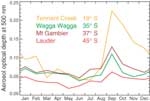PDF of this article (125 KB)


Even kina enjoy a change of scenery: translocating kina to enhance roe
Kina (sea urchin) translocation is a new means of enhancing the roe and increasing the yield from wild kina, particularly from animals found in barrens where the density of kina is very high and the available feed is very low.
Fishers and researchers figure the quality of a kina based on its GI, or gonad index. This is the percentage of the animal’s weight that is made up by the roe, the delicacy for which the sea urchin is harvested. For example, if a kina weighs 200 g and the roe weighs 20 g the GI will equal 10 (or 10%).
NIWA has undertaken a commercial-scale kina translocation trial in two areas of the Coromandel with funding from Seafood Innovations Ltd and in conjunction with Sea Urchin New Zealand. In the trial, we transferred kina from an area where they were abundant, had very low GI values, and food was very limited, to sites where, historically, kina have had very high GI values due to an ample supply of food. The kina were then left at the new sites for about seven months.
The translocated kina showed significant increases in GI in both new sites. Surprisingly, there was an even greater increase in GI in the kina that remained at the original sites compared to those that were translocated. We attribute this significant improvement to the reduction in animal density at these sites and the subsequent re-growth of the algal species they eat. It’s possible that changes in their environment, such as exposure to greater amounts of swell, may account for the poorer performance of the translocated kina compared to those that remained behind. Appropriate site selection is critical for any future translocation ventures.
The increase in GI we measured during the trial ranged between 2.8 and 5.5 (which equates to between 28 kg and 55 kg per tonne of kina). The GI of kina around the Coromandel ranges from 1.2 to 13. In this area, it’s not economic to fish kina with a GI lower than 6. Therefore, the increases we measured in the translocated kina are economically significant, as they increase the yield of the animals by approximately 50–100%. The trial has shown that kina translocation offers an effective method of dramatically increasing the yield of wild-caught kina.
For further information, contact: Dr Phil James, 0-4-380 7982, [email protected]
Tidal energy project gets underway

Tidal-stream electricity generation uses marine turbines – broadly akin to stocky wind turbines – in areas of strong tidal flow. The first turbines are now operating successfully in the Northern Hemisphere. This form of low-carbon energy, envisaged to complement existing renewable resources, comes with its own inherent variability. Understanding this variability in a range of locations is fundamental for a successful industry.
A short voyage into Cook Strait in mid December signalled the start of the field campaign for a new project aimed at optimising the use of tidal energy. We deployed a number of acoustic current meters at strategic locations in the strait to measure the current speeds and also ran experiments to map and measure the eddies in the water.
Typically, most big-picture projects ignore the role of small-scale turbulence processes, or else tack them on as an afterthought. However, tidal flows of four knots or greater, moving around headlands and over submarine ridges, will be very turbulent. Consequently, understanding small-scale fluctuations will be the key to success, as the turbulence upstream of any turbine devices will clearly influence their energy output.
The project, which is funded by the Foundaton for Research, Science and Technology, will look in several other locations in Cook Strait and synthesise the observations with computer models of tidal flow around arrays of turbines. Our objective is to guide efficient arrangement of turbine arrays in real-world situations and provide a baseline understanding for assessing environmental impact.
For further information, contact: Craig Stevens, 0-4-386 0476, [email protected]
